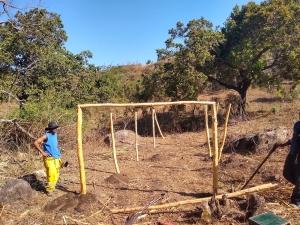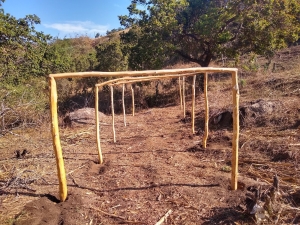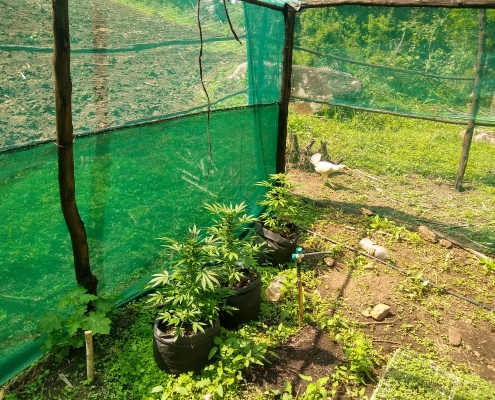Project 6: Greenhouse Build
Introduction
The first phase grow results and conclusions highlighted the need for an updated growing model using a semi-controlled environment to reduce losses and improve outcomes. The decision was taken to build a small greenhouse on the farm and see what improvements it yields.
Aims and Objectives
The Greenhouse was built for the second phase of the research project. The objective was to evaluate the usefulness of a shade-cloth greenhouse in reducing male pollen contamination, reducing problems with pests and improving the success rate of germination.
Built for use as hemp nations grow research facilities but also for Mgadlela farm to use and benefit from.
| Hemp Nation: Greenhouse Project and Cost Break @ Mgadlela Farm | Cost (SZL) |
| As of June ’21 | |
| Poles 6m x 10 @ E60.00 | 600 |
| Shade cloth E2000 | 2000 |
| Roll of wire E300 | 300 |
| Nails and screws | 500 |
| Twine for joining (Donated) | 0 |
| 2 Days work (Unpaid) | 0 |
| Grow bags for small plants | 250 |
| Total | 3650 |
The pictures above show the greenhouse construction in different phases ending with the completed structure.
Partnership Programme
The hands-on nature of this project means that the farmer was very involved in building the greenhouse and learned a lot about its benefits. At this point, the farm has benefited the most from the greenhouse because it gives the farmer a better place to germinate and grow young seedlings with a high success rate before transplanting them to the field. He has ideas of building more greenhouses for his own seedlings and vegetables.
Conclusions
The greenhouse did not solve all the issues we would have hoped. Further work was required on the floor, and plant growth in the greenhouse floor has caused contamination. The number of pests was reduced but not eradicated.
The presence of pollen cannot have been stopped entirely due to seeds found in the plants grown in the greenhouse at harvest.
The shadecloth did not provide enough protection from rain so more plastic sheet had to be added for the roof.
A fence around the greenhouse had to be added to keep away cows and goats.
Such a small greenhouse became very unobtrusive once the surrounding vegetation had regrown. Growth of maize fields and weeds around the greenhouse has completely hidden it from view.
One-seed-one-hole works if the plant matures. Swazi farming techniques go against one seed one hole because they are used to fight against pests that occur naturally and take into account the losses that will occur in the field.
We have documented high losses and may rectify this issue by nursing plants for longer in the greenhouse. The use of chemicals for pest control seems unfortunately necessary at present.
Plants matured at different rates although the same age (massive variety in seed genetics in eSwatini).
The situation in the Summer grow (October to February) was very wet. Summer Male pollen contamination was much worse than winter. A lot of humidity was created in the greenhouse causing some mold and slug issues.
Overall the greenhouse served its purpose well and continues to operate as a research nursery. We continuously modify parts of the greenhouse to make it better and hope to develop it further in the next year.











Leave a Reply
Want to join the discussion?Feel free to contribute!